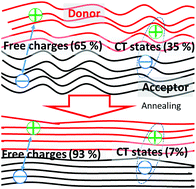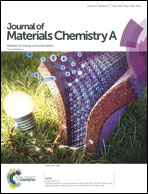Thermal annealing reduces geminate recombination in TQ1:N2200 all-polymer solar cells†
Abstract
A combination of steady-state and time-resolved spectroscopic measurements is used to investigate the photophysics of the all-polymer bulk heterojunction system TQ1:N2200. Upon thermal annealing a doubling of the external quantum efficiency and an improved fill factor (FF) is observed, resulting in an increase in the power conversion efficiency. Carrier extraction is similar for both blends, as demonstrated by time-resolved electric-field-induced second harmonic generation experiments in conjunction with transient photocurrent studies, spanning the ps–μs time range. Complementary transient absorption spectroscopy measurements reveal that the different quantum efficiencies originate from differences in charge carrier separation and recombination at the polymer–polymer interface: in as-spun samples ∼35% of the charges are bound in interfacial charge-transfer states and recombine geminately, while this pool is reduced to ∼7% in thermally-annealed samples, resulting in higher short-circuit currents. Time-delayed collection field experiments demonstrate a field-dependent charge generation process in as-spun samples, which reduces the FF. In contrast, field-dependence of charge generation is weak in annealed films. While both devices exhibit significant non-geminate recombination competing with charge extraction, causing low FFs, our results demonstrate that the donor/acceptor interface in all-polymer solar cells can be favourably altered to enhance charge separation, without compromising charge transport and extraction.



 Please wait while we load your content...
Please wait while we load your content...